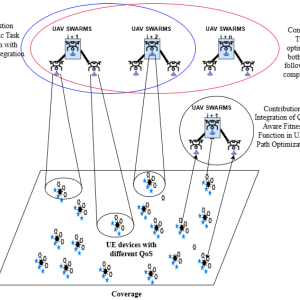The global defense landscape is evolving rapidly, with significant strides being made in the development of unmanned aerial vehicles (UAVs). Among the leading nations in this arena, China has emerged as a formidable force, especially with the introduction of China’s GJ-11 ‘Sharp Sword’ UCAV. This advanced platform represents a crucial step forward in China’s military capabilities, signaling a new era in the nation’s approach to aerial warfare. In this comprehensive analysis, we delve into the technical specifications, strategic implications, and broader geopolitical ramifications of the GJ-11 UCAV.

The Genesis of the GJ-11 ‘Sharp Sword’
China’s pursuit of advanced UCAV technology can be traced back to its broader military modernization efforts, which have been gaining momentum since the early 2000s. The development of the GJ-11 ‘Sharp Sword’ is a testament to the country’s commitment to closing the technological gap with Western powers, particularly the United States. The GJ-11, developed by the Aviation Industry Corporation of China (AVIC), made its public debut during the National Day parade in Beijing in October 2019, showcasing China’s growing expertise in stealth and unmanned technology.
The GJ-11 is part of China’s broader effort to enhance its power projection capabilities, especially in the context of the Asia-Pacific region. This UCAV is designed to perform a variety of missions, including intelligence, surveillance, reconnaissance (ISR), and precision strike operations, making it a versatile tool in China’s military arsenal.
Technical Specifications and Capabilities
The GJ-11 ‘Sharp Sword’ is a flying wing UCAV, a design that has become increasingly popular due to its inherent stealth characteristics. The flying wing configuration minimizes radar cross-section (RCS), making the aircraft less detectable by enemy radar systems. The GJ-11 is believed to have a wingspan of approximately 14 meters and a length of around 10 meters, making it comparable in size to the American Northrop Grumman X-47B UCAV.
Stealth and Radar Evading Technologies
One of the most significant features of the GJ-11 is its stealth capability. The aircraft’s flying wing design, combined with advanced composite materials and radar-absorbent coatings, significantly reduces its RCS. This makes the GJ-11 difficult to detect by enemy radar, allowing it to operate in contested environments where conventional aircraft would be at high risk. Additionally, the UCAV’s exhaust is likely designed to minimize its infrared signature, further enhancing its survivability against enemy air defenses.
Powerplant and Performance
While specific details about the GJ-11’s powerplant remain classified, it is believed to be powered by a single turbofan engine, possibly a derivative of the WS-13 engine, which is used in other Chinese fighter aircraft. The GJ-11 is expected to have a top speed in the subsonic range, with a cruising speed that allows it to loiter in the target area for extended periods. Its range is estimated to be in the thousands of kilometers, enabling it to conduct deep penetration strikes or long-endurance ISR missions.
Payload and Armament
The GJ-11 is designed to carry a variety of precision-guided munitions, making it a potent strike platform. The UCAV features internal weapons bays, a design choice that further enhances its stealth capabilities by reducing the aircraft’s radar signature. The exact payload capacity is not publicly known, but it is believed to be sufficient to carry multiple air-to-ground missiles, bombs, or other guided munitions. This flexibility allows the GJ-11 to engage a wide range of targets, from enemy air defenses to high-value strategic assets.
Autonomous Capabilities and AI Integration
China has made significant investments in artificial intelligence (AI) and autonomous systems, and the GJ-11 is likely to benefit from these advancements. The UCAV is expected to operate with a high degree of autonomy, capable of conducting missions with minimal human intervention. This includes the ability to identify and engage targets autonomously, adapt to changing battlefield conditions, and coordinate with other assets in a networked environment. The integration of AI also enhances the GJ-11’s ISR capabilities, allowing it to process and analyze vast amounts of data in real-time, providing valuable intelligence to commanders.
Strategic Implications for China’s Military
The introduction of the GJ-11 ‘Sharp Sword’ UCAV has significant implications for China’s military strategy, particularly in the context of its growing ambitions in the Asia-Pacific region. The GJ-11 enhances China’s ability to project power beyond its borders, allowing it to conduct long-range strike missions and ISR operations with greater effectiveness. This is particularly important in the context of potential conflicts in the South China Sea, Taiwan Strait, and other contested areas.
Deterrence and Power Projection
The GJ-11 provides China with a credible deterrent against potential adversaries, particularly in scenarios where the use of manned aircraft would be too risky. The UCAV’s stealth capabilities allow it to penetrate deep into enemy territory, delivering precision strikes against high-value targets. This capability is critical for China’s anti-access/area denial (A2/AD) strategy, which aims to prevent adversaries from operating freely in the region. The GJ-11’s ability to conduct ISR missions also enhances China’s situational awareness, allowing it to monitor potential threats and respond rapidly to emerging challenges.
Force Multiplier in Joint Operations
The GJ-11 is designed to operate as part of a broader network of assets, including manned aircraft, other UAVs, and ground-based systems. This makes it a force multiplier in joint operations, enhancing the overall effectiveness of China’s military. The UCAV can be used to suppress enemy air defenses (SEAD), provide ISR support to other assets, and conduct precision strikes in coordination with manned aircraft. This level of integration allows the GJ-11 to play a critical role in complex, multi-domain operations.
Implications for Regional Security Dynamics
The deployment of the GJ-11 ‘Sharp Sword’ is likely to have significant implications for regional security dynamics, particularly in the Asia-Pacific. China’s neighbors, including Japan, South Korea, and Taiwan, are likely to view the UCAV as a significant threat, prompting them to enhance their own defense capabilities. This could lead to an arms race in the region, with other countries seeking to develop or acquire similar technologies to counter China’s growing military power.
Impact on U.S. Military Strategy
The GJ-11’s capabilities are also likely to influence U.S. military strategy in the Asia-Pacific. The United States has long relied on its technological superiority to maintain a strategic advantage in the region, but the GJ-11 represents a potential challenge to that dominance. The UCAV’s stealth capabilities and long-range strike potential could complicate U.S. efforts to project power in the region, particularly in contested areas where the risk to manned aircraft is high. This may lead the U.S. to accelerate its own development of advanced UAVs and other technologies to maintain its edge.
Geopolitical Ramifications
The GJ-11 ‘Sharp Sword’ is not just a military asset; it is also a symbol of China’s growing technological prowess and its ambitions on the global stage. The development and deployment of such an advanced UCAV demonstrate China’s ability to challenge the United States and its allies in the realm of high-end military technology. This has broader geopolitical implications, as it signals China’s intention to assert itself as a global military power.
China’s Position in the Global Arms Market
The GJ-11 also has the potential to enhance China’s position in the global arms market. As more countries seek advanced UAVs to bolster their own military capabilities, the GJ-11 could become a highly sought-after export. This would not only provide China with a significant source of revenue but also increase its influence over other countries’ military strategies. By exporting the GJ-11, China could build stronger defense relationships with key partners, furthering its strategic interests around the world.
Influence on Global Military Doctrine
The introduction of the GJ-11 could also influence global military doctrine, particularly in terms of the use of UAVs in combat. As more countries recognize the advantages of unmanned systems, we are likely to see a shift in how militaries conduct operations. The GJ-11’s capabilities could serve as a model for other countries, leading to the development of similar systems and the incorporation of UAVs into a broader range of missions. This could fundamentally change the nature of warfare, with unmanned systems playing an increasingly central role in military strategy.
The Future of Unmanned Combat Aerial Vehicles
The GJ-11 ‘Sharp Sword’ is a significant milestone in the development of UCAVs, but it is by no means the final word in this rapidly evolving field. As technology continues to advance, we can expect to see even more capable and sophisticated UAVs in the coming years. China is likely to continue investing in this area, seeking to develop new platforms that can operate in increasingly contested environments and perform a wider range of missions.
Potential Countermeasures and Challenges
As with any new military technology, the GJ-11 is likely to face countermeasures from potential adversaries. Nations that perceive the GJ-11 as a threat may develop or deploy advanced radar systems, electronic warfare capabilities, and other technologies to detect and neutralize the UCAV. Additionally, the increasing reliance on AI and autonomous systems raises ethical and operational challenges, particularly in terms of ensuring that these systems operate reliably and predictably in complex environments.
The Role of International Regulations
The proliferation of advanced UCAVs like the GJ-11 also raises important questions about international regulations governing the use of unmanned systems. As more countries develop and deploy these platforms, there is a growing need for international agreements that address issues such as the
proliferation of UAV technology, the rules of engagement for autonomous systems, and the prevention of unintended escalation in conflicts involving unmanned platforms.
Conclusion: The Strategic Significance of the GJ-11 ‘Sharp Sword’
The GJ-11 ‘Sharp Sword’ UCAV represents a significant leap forward in China’s military capabilities, offering a potent combination of stealth, precision strike, and autonomous operation. As China continues to enhance its military power, the GJ-11 is likely to play a central role in its strategy for regional dominance and global influence. The development and deployment of this advanced UCAV have far-reaching implications for military strategy, regional security, and international relations, making it a critical asset in the evolving landscape of unmanned aerial warfare.
As the world watches the rise of China’s military capabilities, the GJ-11 stands as a symbol of the country’s growing ambition and technological prowess. Whether it is viewed as a threat or an opportunity, there is no doubt that the GJ-11 ‘Sharp Sword’ will be a key factor in shaping the future of warfare in the 21st century. The international community must carefully consider the implications of this development and work towards a balanced approach that addresses the challenges and opportunities presented by the rise of advanced unmanned systems.










